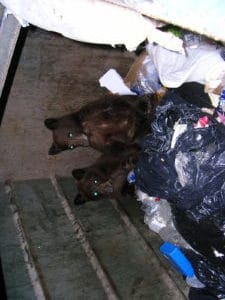Share this article
Study maps human-bear conflicts in Nevada
Researchers recently mapped hotspots for human-bear conflicts in the Great Basin using long-term data on bear mortality.
Once gone from the Nevada landscape, black bears (Ursus americanus) have been gradually returning, and as their numbers have increased, they have begun showing up in urban areas, attracted to garbage and other attractants, leading to more and more run-ins with humans.
Nevada’s black bears were extirpated in the early 1900s, along with grizzly bears (Ursus arctos), due to factors like logging and conflicts with livestock and a growing number of residents. But as human uses of the landscape changed, black bears began to return.
“Post-World War II, there was a reduction in reliance on wood for fuel sources and an increase in use of fossil fuels leading to recovery of forested habitat,” said TWS member Jon Beckmann, director of science for the Wildlife Conservation Society’s Rocky Mountain West program. By the 1980s and early 1990s, black bear populations were regenerating, he said.

Black bears in Lake Tahoe and the Western Great Basin Desert in Nevada face mortality primarily from road collisions and removal after nuisance behavior. ©Jon Beckmann, WCS
As a result, Beckmann and his colleague Carl Lackey at the Nevada Department of Wildlife began collecting long-term data on black bears about 20 years ago, including mortality data, in an effort to drive management recommendations. Beckmann led a study on the bears with the most recent data published in Global Ecology and Conservation.
He and his team studied bear deaths in the Lake Tahoe Basin and Western Great Basin Desert in Nevada between 1997 and 2013 using VHF and GPS collars. They found that vehicle collisions and removal of bears after they caused property damage were the largest causes of mortality. They also determined that in drier areas with more frequent droughts, bears were more likely to rely on anthropogenic food sources, which can result in more human-bear conflict.
Conservation biologist Rae Wynn-Grant, then a PhD student at Columbia University, modeled these conflict hotspots as well as areas where bears are likely to recolonize and create more human-bear conflicts.
“We are giving the information to Nevada Department of Wildlife to stay ahead of the recolonizing front where there may be conflicts and to educate people about bears returning,” Beckmann said.
Since bears often raid garbage cans and bird feeders and sometimes break into cars and homes, the information can help prepare people in communities that haven’t seen a bear in more than 80 years, he said, and other states can benefit, too. If they follow use a similar approach to model their hotspots, Beckmann said, they can find out not only where current conflicts occur but where they might arise as bears expand their ranges.
“A lot of areas don’t want to get to the level of conflict we had in Nevada,” he said.
Header Image: Roads can be dangerous places for black bears. ©JanetandPhil








